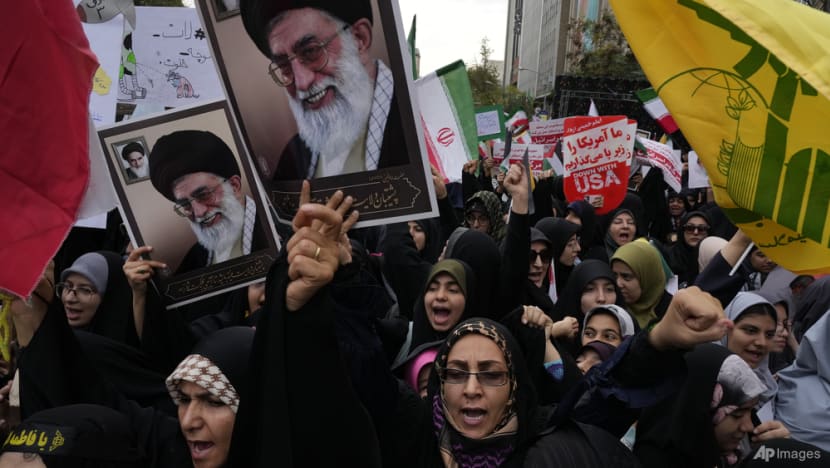Commentary: Stakes will only get higher in the Middle East under second Trump term
Assessments of the region will be on hold until Israel is done with Hamas and Hezbollah, and a big question is what Benjamin Netanyahu will do during Donald Trump’s second presidency, says Carl Skadian from the NUS Middle East Institute.


This audio is generated by an AI tool.
SINGAPORE: Middle Eastern leaders now find themselves having to deal with a new reality of Donald Trump as the next president of the United States. While he is not an unknown quantity this time around, his election will be greeted with optimism in some countries and dread in others.
Without a need to seek re-election in 2028, Trump will be largely unfettered in pursuit of his goals, and perhaps only limited by a desire to cement a legacy – both for himself, and for the MAGA movement he spawned. In this respect, a clear winner of the US election outcome will be Israel.
Prime Minister Benjamin Netanyahu certainly thought so and wasted no time in being among the first to offer his congratulations to the incoming president.
During his first term, Trump handed a number of gifts to Israel, including recognising Jerusalem as its capital, the annexed Golan Heights as its territory, and delivering the Abraham Accords that normalised relations between Israel and several Arab states.
This time around, at a time of heightened tensions in the Middle East, Trump’s gift may be to look away and let Israel “finish the job”, as he has said.
ISRAEL’S GAIN, PALESTINIANS’ LOSS
At least in the short run, Israel’s gain is the Palestinians’ loss.
Without saying what peace will look like or how it will be achieved, Trump may allow Netanyahu to pursue his goals in Gaza and Lebanon without restraint. His pick of Elise Stefanik – a staunch backer of both Trump and Israel – as the US ambassador to the United Nations will also provide American cover for the state at the world body.
After Trump was first elected in 2016, his administration had broadly rejected the long-held US policy that West Bank settlements were an obstacle to peace. With settlers now increasingly bold in their attacks, de facto American legitimisation of their activity will mean Palestinians stand to lose more land, and perhaps suffer more violence.
A two-state solution appears ever further out of reach. A possible silver lining further down the line, however, is that Trump may come to see that ending the Israeli-Palestinian conflict is one sure way of securing his legacy, and may devote the full power of his office to achieve this.
However, the entrenched nature of the conflict, and strident Israeli opposition to a Palestinian state, will likely ensure that this remains an elusive goal.
GOOD NEWS FOR SAUDI ARABIA, UAE
Two other likely winners of Trump 2.0 are Saudi Arabia and the United Arab Emirates.
The former will finally turn the page on being called a “pariah” by outgoing President Joe Biden, and the values-based relationship it had with Democrats. By contrast, Trump avoided any mention of human rights during his first term.
The President-elect’s affinity for strongmen means he shares a close personal relationship with the Saudi and Emirati leaders. Combined with his transactional approach to foreign policy, strong economic ties will likely be a hallmark of the relationships.
This is good news for the Gulf states’ transformation projects. China’s growing interest in the region adds another arrow to their quiver in their bid to push their economic agendas front and centre, and could be useful as a bargaining chip in dealings with a mercantilist president. This also spells clear skies ahead for their other key priority: Robust security guarantees.
It must be noted, however, that Trump’s failure to respond to the attacks on Saudi oil facilities in 2019 – claimed by Yemen’s Houthi militia, but which the US blamed on Iran – was among the sparks that led to much hand-wringing in the region and elsewhere that America was in retreat across the Middle East. The Hamas attacks last October revealed this to be a mistaken assumption.
To build on his Abraham Accords achievement, Trump may continue to push for a Saudi-Israel normalisation deal, which was within grasp until Hamas attacked.
QATAR WILL BE WORRIED
One Gulf state that might be more worried about Trump than others is Qatar.
The tiny emirate’s first encounter with him did not go well at all: Just days after a Saudi-led coalition imposed a blockade on Qatar – and only a few months into his first presidency – Trump accused it of sponsoring terror, echoing the accusations made by the blockading states.
Though he eventually walked the comments back, the scar remains. This partly explains Qatar’s decision, just days after Trump’s election last week, to suspend crucial Gaza mediation efforts and to reportedly ask Hamas leaders to leave the country.
Doha did hedge its bets, however, by keeping open the possibility of future talks if “good faith” efforts to seek peace surfaced. This suggests the emirate is trying to tread a fine line in preparation for another Trump presidency.

IRAN, THE CLEAR LOSER
That leaves a clear loser after the US election: Iran. Despite its stated interest in forging a new beginning with the West after the election of a new president in July, hopes were always faint in the wake of the Hamas attacks.
Its supply of weaponry to Russia for its war against Ukraine has further isolated the regime from the West, as has its embrace of China. To make matters worse, American officials last week revealed the existence of an Iranian plot to assassinate Trump, something the President-elect will no doubt take personally.
The previous Trump administration drove the “maximum pressure” campaign that has left the Iranian economy in ruins, and, in so doing, ramped internal discontent up several notches. The expected appointment of two Iran hawks to top foreign policy and security posts – Senator Marco Rubio as Secretary of State, and Congressman Michael Waltz as National Security Adviser – hints at what lies ahead.
There is little doubt Trump will continue to turn the screws on Tehran, and, with the issue of Supreme Leader Ali Khamenei’s succession looming, the Islamic Republic faces an uncertain path ahead.
As Saudi Arabia and the UAE grow more muscular – this, and Iran’s own weaknesses, forced it to seek accommodation with its Arab neighbours, leading, most famously, to détente with Riyadh – Tehran is left with little room for manoeuvre.
How it will fare with the US jumping on its back again for the next four years will depend on how it chooses to operate in the rapidly shrinking space it finds itself in. A sign that Iran’s government is scrambling to assess its options are the calls being made by former officials and in newspaper editorials to seek ways to engage with Trump’s administration, first reported by The New York Times.
BRACE FOR TURBULENCE
It is early days yet, and in a region where it has been said that the future is next week, there is much that can upend these trends. As with all the other assessments put forward here thus far, everything will remain on hold until Israel is done with Hamas and Hezbollah.
Only one thing is for certain: Adding a mercurial American president to the issues that continue to make the Middle East a tinderbox should make everyone brace for turbulence.
Carl Skadian, a former journalist and editor for 30 years, is Senior Associate Director at the Middle East Institute, NUS.


















